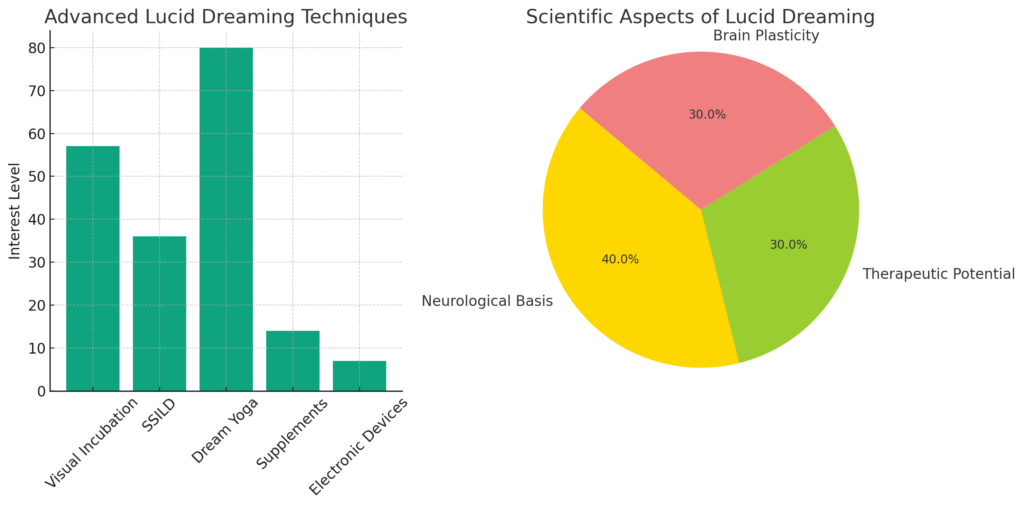Exploring Lucid Dreaming: Techniques and Insights

Key Takeaways
| Aspect | Key Point |
|---|---|
| Definition | Understanding the concept of lucid dreaming |
| Techniques | Best practices for inducing lucid dreams |
| Benefits | Exploring the benefits of lucid dreaming |
| Comparison | Differentiating between lucid dreaming and astral projection |
| Resources | Internal links to further explore related topics |
Lucid dreaming, a fascinating state where the dreamer is aware they are dreaming and can often control the narrative, has been a subject of intrigue and study for centuries. This phenomenon blurs the lines between the conscious and subconscious mind, offering a unique platform for personal exploration and growth.
Techniques for Inducing Lucid Dreams
- Reality Testing: Regularly check your environment throughout the day to determine if you’re dreaming. This habit can carry over into your dreams, triggering lucidity.
- Wake Back to Bed (WBTB): This involves waking up after 5-6 hours of sleep, staying awake briefly, and then going back to sleep. This method increases the chances of entering REM sleep, where lucid dreams are more likely.
- Mnemonic Induction of Lucid Dreams (MILD): Before sleeping, repeat a mantra expressing your intention to realize you’re dreaming. This technique plants the seed for lucidity in your subconscious.
- Keeping a Dream Journal: Writing down your dreams enhances dream recall and awareness, making it easier to recognize dream signs and become lucid.
- Meditation and Mindfulness: Regular practice of meditation and mindfulness can cultivate a heightened awareness that is beneficial for recognizing the dream state.

Benefits of Lucid Dreaming
Lucid dreaming isn’t just a fascinating experience; it holds numerous benefits:
- Enhanced Problem-Solving: The creative freedom in lucid dreams can lead to innovative solutions to real-life problems.
- Emotional Resolution: Confronting and interacting with dream characters or scenarios can provide emotional catharsis and insight.
- Skill Practice: Lucid dreamers often use this state to practice and improve real-life skills, as the neurological patterns formed are similar to those created during actual practice.
- Overcoming Fears: By facing fears in a controlled dream environment, individuals can make significant progress in overcoming their phobias.
Lucid Dreaming and Astral Projection: A Comparison
While lucid dreaming occurs within the confines of one’s mind, astral projection (AP) is believed to involve the consciousness or ‘soul’ traveling outside the physical body. To explore this fascinating topic further, check out our insightful article on Astral Projection vs Lucid Dreaming.
For an in-depth review of the experiences and practices surrounding lucid dreaming, our Lucid Dreaming Review offers comprehensive insights.

Additional Resources
To delve deeper into similar phenomena, our guide on Astral Projection Techniques provides a comprehensive overview of practices to achieve out-of-body experiences.
Advanced Lucid Dreaming Techniques and Scientific Insights
Advanced Techniques for Enhanced Lucid Dreaming
Moving beyond the basics, here are some advanced techniques for those seeking to deepen their lucid dreaming practice:
- Visual Incubation: Before sleep, visualize a specific scenario you wish to experience in your dream. This method can set the stage for the dream narrative.
- Sensory Induced Lucid Dreaming (SSILD): This technique involves cycling through your senses before sleep to increase sensory awareness, potentially triggering lucidity.
- Dream Yoga: Originating from Tibetan Buddhism, this practice combines meditation with dream work, aiming to maintain consciousness during the dream state.
- Choline and Galantamine Supplements: Some lucid dreamers use these supplements to enhance dream clarity and recall. However, it’s essential to consult a healthcare professional before trying any supplements.
- Electronic Lucid Dream Induction Devices: These devices detect REM sleep and use cues like light or sound to alert the dreamer that they are dreaming without waking them up.
The Science Behind Lucid Dreaming
Lucid dreaming has piqued the interest of scientists, leading to fascinating discoveries:
- Neurological Basis: Studies using EEG and fMRI have shown that lucid dreaming involves unique brain activity, particularly in the frontal lobes, which are associated with higher cognitive functions.
- Therapeutic Potential: Lucid dreaming has been explored as a treatment for conditions like PTSD and nightmares, as it allows individuals to consciously address and reshape their dream content.
- Impact on Brain Plasticity: Engaging in lucid dreaming may enhance brain plasticity, improving cognitive abilities and creativity.
Expanding Your Understanding
For those interested in exploring the intersection of dreams and consciousness further, our in-depth Lucid Dreaming Review provides comprehensive insights into the practice.
Also, to understand a closely related phenomenon, our article on Astral Projection Techniques offers a detailed look at methods to experience out-of-body experiences.

Integrating Lucid Dreaming into Daily Life
Practical Applications and Daily Integration
Lucid dreaming, while an intriguing experience in itself, can also have practical applications in daily life:
- Creative Inspiration: Artists, writers, and musicians can tap into their lucid dreams for creative ideas and inspiration.
- Personal Development: Lucid dreaming offers a safe space to explore various aspects of the self, aiding in personal growth and self-awareness.
- Problem-Solving: Complex problems can be approached creatively within the lucid dream state, often leading to innovative solutions.
- Stress Relief and Relaxation: Engaging in pleasant dream scenarios can be a form of escapism and relaxation, helping to reduce stress.

Tips for Integrating Lucid Dreaming into Your Routine
- Set Intentions Before Sleep: Spend a few minutes before bed setting your intentions for what you wish to explore or achieve in your dreams.
- Morning Reflections: Upon waking, take a moment to reflect on your dreams and any insights they may have provided.
- Use Lucid Dreaming Apps: Various apps are designed to help induce and track lucid dreams, making the process more accessible.
- Join Lucid Dreaming Communities: Online forums and groups can provide support, tips, and shared experiences to enhance your practice.
Lucid Dreaming for Wellness and Healing
Lucid dreaming has the potential to contribute significantly to emotional and mental wellness:
- Emotional Processing: It allows for the confrontation and processing of emotions in a controlled environment.
- Healing Trauma: By reliving and reinterpreting traumatic events in a safe dream space, individuals can find healing and closure.
- Enhancing Self-Esteem: Achieving control and success in dreams can boost confidence and self-esteem in waking life.
Continued Learning and Exploration
For those who wish to explore the broader context of dreams and consciousness, the articles Astral Projection vs Lucid Dreaming and Astral Projection Techniques offer deeper insights into related phenomena.

Exploring the Ethical and Cultural Dimensions of Lucid Dreaming
Ethical Considerations in Lucid Dreaming
As with any practice involving the mind and consciousness, lucid dreaming raises some ethical questions:
- Moral Responsibility: Does one have moral responsibilities for actions taken within a lucid dream?
- Influence on Reality Perception: How might regular lucid dreaming affect one’s perception of reality and ability to distinguish between dream and waking states?
- Privacy and Consent: In a world increasingly focused on privacy, the exploration of others in dream scenarios raises questions about consent, even in an imaginary context.
Cultural Perspectives on Lucid Dreaming
Different cultures have varied perspectives on lucid dreaming, often linked to their broader spiritual and philosophical beliefs:
- Western Views: Often seen through a psychological lens, focusing on the mind and self-improvement.
- Eastern Traditions: Lucid dreaming is sometimes integrated into spiritual practices, seen as a tool for enlightenment or spiritual insight.
- Indigenous Beliefs: Some indigenous cultures view lucid dreaming as a connection to ancestral wisdom and the spirit world.
The Future of Lucid Dreaming Research
As interest in lucid dreaming grows, so does the potential for future research:
- Technological Advances: Developments in neuroimaging and sleep technology could provide deeper insights into the lucid dreaming process.
- Interdisciplinary Studies: Combining psychology, neurology, and even philosophy could lead to a more comprehensive understanding of lucid dreaming.
- Application in Therapy: Exploring its use in therapeutic settings, particularly for mental health disorders, could open new treatment avenues.
Further Reading and Resources
To expand your understanding of dreams and consciousness, consider exploring our related articles on Astral Projection vs Lucid Dreaming and Astral Projection Techniques.

Conclusion: Embracing the World of Lucid Dreaming
Lucid dreaming presents a realm of limitless possibilities, a bridge between our conscious and subconscious minds. It’s a practice that not only fascinates but also empowers, allowing us to explore inner worlds, confront personal challenges, and unlock creative potential.
Through the various techniques and insights discussed, from basic practices like reality testing and dream journaling to advanced methods like sensory induced lucid dreaming (SSILD) and dream yoga, individuals can tailor their approach to exploring this unique state of consciousness.
The benefits of lucid dreaming extend beyond mere curiosity. They offer tangible improvements in problem-solving, emotional processing, and personal development. Moreover, the integration of lucid dreaming into daily life—be it for stress relief, creative inspiration, or therapeutic purposes—highlights its versatility and relevance in modern times.
However, as with any exploration of the mind, ethical and cultural considerations are paramount. Understanding and respecting these dimensions ensures a responsible and enriching journey into the world of lucid dreams.
As research continues to unfold, revealing more about the science behind lucid dreaming and its potential applications, we stand on the brink of deeper understanding and appreciation of this remarkable phenomenon.
For those interested in further exploring the realms of consciousness, dreams, and beyond, the articles on Astral Projection vs Lucid Dreaming and Astral Projection Techniques provide valuable insights and knowledge.
In conclusion, lucid dreaming is not just a fascinating nocturnal adventure; it’s a tool for self-discovery, a canvas for creativity, and a path to emotional and mental well-being. As we continue to explore and understand its depths, we unlock the profound potential that lies within our dreaming minds.